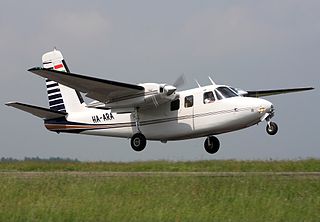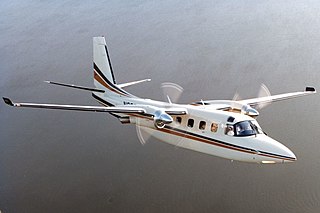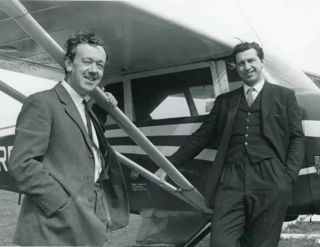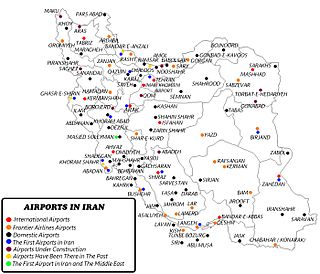
North American Aviation (NAA) was a major American aerospace manufacturer that designed and built several notable aircraft and spacecraft. Its products included the T-6 Texan trainer, the P-51 Mustang fighter, the B-25 Mitchell bomber, the F-86 Sabre jet fighter, the X-15 rocket plane, the XB-70 bomber, the B-1 Lancer, the Apollo command and service module, the second stage of the Saturn V rocket, and the Space Shuttle orbiter.

The Robert J. Collier Trophy is awarded annually for the greatest achievement in aeronautics or astronautics in America, with respect to improving the performance, efficiency, and safety of air or space vehicles, the value of which has been thoroughly demonstrated by actual use during the preceding year.
The Call Aircraft Company was established by Reuel Call in 1939 at Afton, Wyoming, to build a touring aircraft of his own design.

Aero Commander was an aircraft manufacturer formed in 1944. In subsequent years, it became a subsidiary of Rockwell International and Gulfstream Aerospace. The company ceased aircraft production in 1986.

The Aero Commander 500 family is a series of light-twin piston-engined and turboprop aircraft originally built by the Aero Design and Engineering Company in the late 1940s, renamed the Aero Commander company in 1950, and later a division of Rockwell International in 1965. Final production occurred under the Gulfstream Aerospace name. The initial production version was the 200 mph, seven-seat Aero Commander 520. An improved version, the 500S, manufactured after 1967, is known as the Shrike Commander. Larger variants are known by numerous model names and designations, ranging up to the 330 mph, 11-seat Model 695B/Jetprop 1000B turboprop. As of recent, the Aero Commander is known as the Twin Commander.

The PZL-Mielec M-18 Dromader is a single engine agricultural aircraft that is manufactured by PZL-Mielec in Poland. The aircraft is used mainly as a cropduster or firefighting machine.

The Aero Commander 100, various models of which were known as the Darter Commander and Lark Commander, is an American light aircraft produced in the 1960s. It was a high-wing monoplane of conventional design, equipped with fixed tricycle undercarriage.

The Ayres Thrush, formerly the Snow S-2, Aero Commander Ag Commander, and Rockwell Thrush Commander, is an American agricultural aircraft produced by Ayres Corporation and more recently by Thrush Aircraft. It is one of the most successful and long-lived agricultural application aircraft types in the world, with almost 2,000 sold since the first example flew 68 years ago. Typical of agricultural aircraft, it is a single-seat monoplane of conventional taildragger configuration. Originally powered by a radial piston engine, most examples produced since the 1980s have been turboprop-powered.

Thrush Aircraft, Inc. is an American aircraft manufacturer based in Albany, Georgia. It currently manufactures the Thrush series of agricultural aircraft.

Ayres Corporation was an American aircraft manufacturer owned and run by Fred Ayres.

Snow Aeronautical was an American aircraft manufacturer established in 1956 in Olney, Texas by Leland Snow to manufacture and market agricultural aircraft of his design.

Air Tractor Inc. is a United States aircraft manufacturer based in Olney, Texas. Founded in 1978, the company began manufacturing a new agricultural aircraft derived from the S-2B aircraft. Designated Model AT-300 Air Tractor, the new aircraft first flew in 1973.

The Honeywell TPE331 is a turboprop engine. It was designed in the 1950s by Garrett AiResearch, and produced since 1999 by successor Honeywell Aerospace. The engine's power output ranges from 575 to 1,650 shaft horsepower.

Conair Group Inc. of Abbotsford, British Columbia, Canada, formerly known as Conair Aviation, is a company specializing in retrofitting firefighting aircraft, maintaining customer and company-owned aircraft and aerial firefighting. Conair currently employs over 250 staff and has a fleet of aircraft that are broken down into two categories; air attack, and airtankers. Conair specializes in fire management support by providing services and products to forest protection agencies around the world. In 1996 Conair became a Canadian Air Tractor dealer for the AT-802F air tanker. A former Conair Group division; Cascade Aerospace was acquired by the IMP Group of Halifax, Nova Scotia in 2012.

The Wright R-1300 Cyclone 7 is an American air-cooled seven-cylinder supercharged radial aircraft engine produced by Curtiss-Wright.
Marsh Aviation is an aircraft engineering, design, maintenance and re-manufacturing company, situated on East Falcon Drive, at Falcon Field in Mesa, Arizona. The company often works as a sub-contractor to well-known brand-name aerospace companies, discreetly designing and manufacturing components and sub-systems for high-profile programs. The company has also worked on a variety of aircraft programs for governments all over the world.

Nigel Desmond Norman, was an aircraft designer and aviation pioneer. Norman co-founded Britten-Norman in 1954, was appointed a Commander of the Order of the British Empire in 1970, and served as chairman and managing director of AeroNorTec (1988–2002). With his longtime friend and business partner John Britten, he also designed, built, and sailed racing yachts, as well as a series of air cushion vehicles and crop spraying equipment. He died of a heart attack at age 73 in 2002.

The Civil Aviation Authority of Islamic Republic of Iran (CAA.IRI), is Iran's civil aviation agency. It is the statutory corporation which oversees and regulates all aspects of civil aviation in Iran. The organization was established in July 1946 and its headquartered at Mehrabad International Airport in Tehran. It investigates aviation accidents and incidents in Iran.

Dalby Airport is a small airport located 1.2 kilometres (0.75 mi) north of the town of Dalby, Queensland Australia. The airport is mostly used for small private light aircraft and agricultural aviation services as well as occasional emergency aircraft including those of the Royal Flying Doctor Service. The airport also sees a daily weekday return mail service operated by GAMAir using Aero Commander 500S aircraft. It also hosts the Dalby Aeroclub, and the Dalby Hang Gliding Club.

















